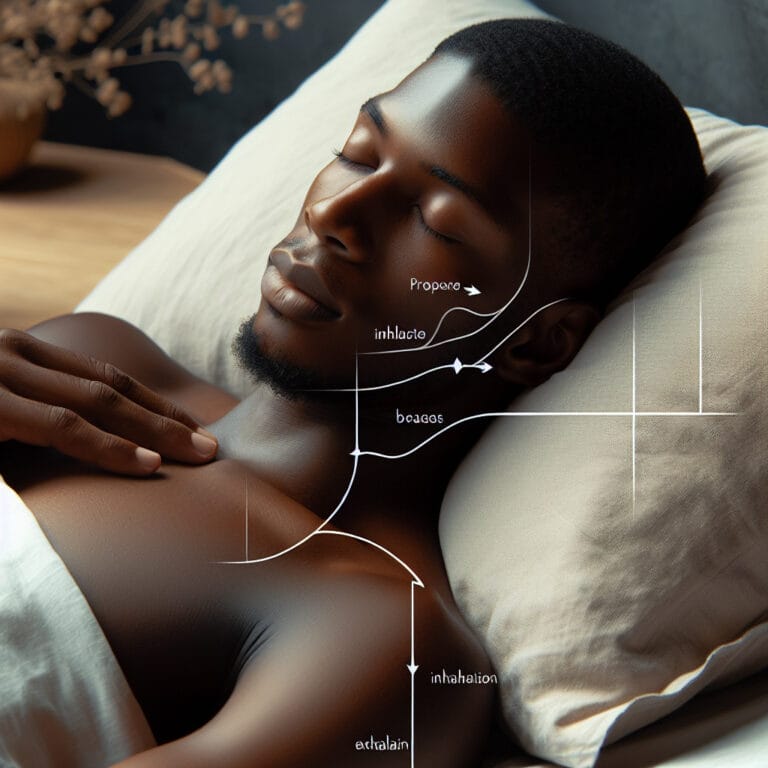
Harness the Power of Breathing Strategies for a Better Sleep
Table of Contents
- Introduction
- The Science Behind Sleep and Breathing
- Popular Breathing Techniques for Better Sleep
- How to Incorporate Breathing Strategies into Your Nightly Routine
- Benefits of Using Breathing Strategies for Sleep
- Conclusion
- Frequently Asked Questions
Introduction
The critical role that high-quality sleep plays in our overall health and wellbeing cannot be overstated. It’s not just about feeling refreshed and alert; research shows that restful sleep is essential for everything from maintaining a healthy heart rate and blood pressure to burning calories and losing weight. But what if the secret to falling asleep, staying asleep, and reaping all these health benefits could be as simple as changing the way we breathe?
Indeed, a growing body of evidence suggests that adopting certain breathing techniques can dramatically improve sleep quality. Normal breathing tends to become shallow during periods of stress or anxiety, which can elevate our heart rate and make it harder to fall asleep or stay asleep. By contrast, deep breathing exercises help reduce anxiety by triggering our relaxation response – a state of deep rest that changes our physical and emotional responses to stress.
One popular breathing exercise for promoting restful sleep is bhramari pranayama, or “bee breath,” which involves inhaling deeply through your nose then making a humming sound while exhaling slowly. Research shows this technique helps increase production of delta brain waves, those associated with deep, reparative stages of sleep where memory consolidation occurs.
Another effective method is Papworth method; it combines diaphragmatic breathing with specific attention towards rhythm and nasal breathing. This technique has been shown to decrease symptoms related to conditions like insomnia by reducing irregular or erratic respiration habits.
These are merely two examples among many possible breathing exercises one may incorporate into their pre-sleep routine. Also part of good ‘sleep hygiene’ is consistent practice – incorporating it every night allows you time to hone your skill at these methods whilst establishing them as positive pre-bedtime rituals aiding in inducing a sense of calm needed for seamless transition into slumber.
So how does all this work? When we breathe deeply during these exercises, we increase levels of carbon dioxide in our blood – paradoxically this actually helps relax smooth muscle tissues throughout the body, slows our heart rate and assists in lowering blood pressure. This physiological state is conducive to falling asleep and staying asleep longer.
In a world where sleep deprivation is worryingly common, these simple, natural strategies could be game-changing. So why not give sleep breathing exercises a try? By helping you to fall asleep quicker, stay asleep longer and achieve more restful sleep – they might just provide the healthy boost your body needs.
The Science Behind Sleep and Breathing
Whether you’re actively trying to lose weight, maintain a healthy heart rate, or simply improve your overall health, a good night’s sleep should top your list of priorities. Transitioning into high-quality sleep might be easier than you think – and it all comes down to the way we breathe. It’s fascinating to note that while normal breathing patterns can become shallow during periods of stress or unease, an intentional shift towards deeper breaths can dramatically influence our ability to fall asleep and stay asleep.
A better understanding of the sleep cycle helps shed light on this remarkable relationship between proper breathing techniques and restful sleep. During sleep, our bodies go through several stages ranging from light slumber to deep REM (rapid eye movement) stages where dreams occur. Between these lies the stage resonating with delta brain waves – these are associated with deep reparative phases where memory consolidation happens. Research shows that certain breathing exercises like bhramari pranayama significantly boost production of these delta waves leading us naturally into profound restfulness.
But how exactly do such breathing techniques work their magic? As we engage in any given exercise – whether it’s taking one long calming deep breath or practicing structured routines like Papworth method – we consciously slow down our respiration rate causing an increase in the carbon dioxide levels in our blood. This may sound alarming but is quite beneficial; increased CO2 relaxes smooth muscle tissues throughout the body resulting in lowered blood pressure and slower heart rate which are ideal conditions for falling asleep seamlessly.
Breathing strategies aren’t just about inhaling deeply though; they also involve paying attention to exhalation which has its own suite of benefits. For instance, when exhaling lengthier as compared to inhalation during exercises like 4-7-8 technique (inhale for 4 seconds, hold for 7 seconds then exhale for 8 seconds), we activate parasympathetic nervous system responsible for inducing calmness and relaxation, thus making it easier to fall asleep.
In these stressful times, many of us struggle with anxiety which is a common impediment to restful sleep. Here too, breathing exercises come handy; consciously slowing down breaths can significantly reduce anxiety and pave way for calmer state of mind crucial for high-quality sleep.
Investing time in understanding and practicing various breathing techniques sets a solid foundation for good ‘sleep hygiene’. So next time you find yourself tossing and turning at night, remember: the secret to falling asleep might be as simple as taking a conscious deep breath. Who knew that something we do naturally without giving much thought could have such profound effects on our health when done mindfully? In embracing these techniques and integrating them into your nighttime routine, you’ll be well on your way towards achieving more restful nights filled with high-quality sleep.
Popular Breathing Techniques for Better Sleep
It’s fascinating to note that just a slight shift in the way we breathe can profoundly influence our sleep quality. One such potent breathing exercise is the 4-7-8 technique designed specifically to reduce anxiety and help you fall asleep more quickly. This method is straightforward; start by emptying your lungs entirely, then inhale quietly through your nose for a count of four seconds. Hold your breath for seven seconds, and exhale forcefully through your mouth, making a whoosh sound for eight seconds. Repeat this cycle at least three times or until you feel calm and ready to drift off into a restful sleep.
Box breathing, also known as square breathing or four-square breathing, is another effective technique that aids in stress management and relaxation—ultimately promoting high-quality sleep. It’s called box-breathing because it involves four equal parts: inhaling for four seconds, holding the breath for an equal amount of time, exhaling slowly over another count of four, followed by holding the breath again for the same duration before repeating the cycle. This simple yet powerful practice helps regulate normal breathing patterns disrupted due to stress or anxiety and encourages deeper engagement with our physiology—decreasing heart rate while increasing alertness.
Next on our list is Diaphragmatic Breathing—a game-changer when it comes to enhancing sleep quality. Unlike shallow breathing where air doesn’t reach lower lung areas leading to less optimal oxygen-carbon dioxide exchange affecting overall health negatively; diaphragmatic breathing focuses on engaging diaphragm allowing a fuller range of oxygen flow throughout lungs during each inhalation-exhalation cycle thereby improving respiratory efficiency which translates into better body functioning including improved ability to stay asleep longer.
Finally let’s delve into an ancillary approach – Progressive Muscle Relaxation (PMR). While not exactly being categorised as a ‘breathing exercise,’ its significance in inducing restful sleep cannot be understated. PMR revolves around tensing various muscle groups and then releasing that tension. This rhythmic tightening and loosening of muscles, when paired with deep breaths, contribute towards lowering blood pressure and calming mind—two essential conditions for achieving high-quality sleep. By practicing these techniques consistently as part of your sleep hygiene routine, you actively train your body to relax at will—a crucial step in falling asleep effortlessly.
When it comes to improving sleep quality, incorporating these breathing exercises into your nightly routine could be the key. From the 4-7-8 technique’s anxiety-reducing effects to the restorative benefits of Box Breathing; from diaphragmatic breathing enhancing overall respiratory efficiency leading us naturally into deeper levels of relaxation to PMR’s role in calming mind – the power of proper breathing should not be underestimated. So why wait? Try them out tonight and experience firsthand how they can help you fall asleep quicker, stay asleep longer, and achieve more restful nights filled with high-quality sleep.
| Technique | Description | Benefits |
|---|---|---|
| 4-7-8 Breathing | Inhale for 4 seconds, hold your breath for 7 seconds, and exhale for 8 seconds. | Reduces anxiety, helps you fall asleep more quickly. |
| Box Breathing | Inhale, hold your breath, exhale, and hold your breath again, each for 4 seconds. | Helps manage stress, promotes high-quality sleep, regulates normal breathing patterns disrupted due to stress or anxiety, decreases heart rate while increasing alertness. |
| Diaphragmatic Breathing | Focuses on engaging diaphragm allowing a fuller range of oxygen flow throughout lungs during each inhalation-exhalation cycle. | Enhances overall respiratory efficiency, improves body functioning, helps to stay asleep longer. |
| Progressive Muscle Relaxation (PMR) | Revolves around tensing various muscle groups and then releasing that tension, paired with deep breaths. | Lowers blood pressure, calms mind, induces restful sleep. |
How to Incorporate Breathing Strategies into Your Nightly Routine
In the quest for high-quality sleep, creating a sleep-friendly environment is paramount. A serene surrounding aids in making breathing exercises more effective, enabling you to fall asleep and stay asleep longer. Start by decluttering your bedroom and dimming the lights to create a calm ambiance that reduces anxiety and promotes relaxation. Use noise-cancelling earplugs if necessary to block out distracting sounds; remember, tranquility is key when it comes to practicing breathing techniques effectively.
Before starting any breathing exercise, whether it’s bhramari pranayama or the Papworth method, proper positioning matters. Research shows that maintaining an upright posture with a straight back helps augment lung capacity facilitating deeper breaths while lying down relaxes muscles further helping induce restful sleep quicker. Ensure your body is comfortable before delving into these practices.
While these exercises can be done at any time of day to help destress and calm your mind, they are particularly useful as part of your pre-bedtime routine – this practice forms an integral part of good ‘sleep hygiene’. Guided by research findings revealing that heart rate naturally decreases in the evening preparing our body for rest; engaging in deep-breath centered activities around this time syncs harmoniously with our body’s natural rhythm optimizing results obtained from these techniques.
Let’s not forget about nutrition either; consuming caffeine-laden or heavy meals close to bedtime can disrupt normal breathing patterns. Instead opt for foods known to promote melatonin production – the sleep hormone which eases transition into slumber when paired with effective breathing strategies.
Breathing exercises play a pivotal role in achieving high-quality sleep; but remember their effectiveness multiplies manifold when integrated within holistic approach towards improving ‘sleep hygiene’ – one including balanced diet, regular exercise alongside consistent practice of chosen breathing technique within conducive environment specifically designed for inducing restful sleep without interruptions.
Benefits of Using Breathing Strategies for Sleep
Delving into the profound connection between the rhythm of our breaths and sleep quality reveals some remarkable insights. Breathing exercises like bhramari pranayama have a proven track record in enhancing high-quality sleep, thanks to their effectiveness in stimulating delta brain waves—the cornerstone of restful sleep. Shallow breathing, a common byproduct of stress or anxiety, can disrupt these vital brain waves, leading to fragmented sleep or even insomnia. By contrast, adopting controlled deep-breath techniques helps not only reduce anxiety but also regulates heart rate and blood pressure—crucial factors influencing how quickly we fall asleep and stay asleep.
Moreover, research shows that daily practice of these specific breathing techniques could potentially result in reduced dependence on sleeping aids or medications—a victory both for your health and your wallet. The Papworth method—a popular breathing exercise focussing on rhythmic diaphragmatic breathing is an exemplary case where consistent practice has resulted in notable reductions in symptoms related to conditions like insomnia.
Regularly engaging in such exercises before bedtime can play a pivotal role in improving one’s overall ‘sleep hygiene’. They help align our physiological state with the tranquil environment required for seamless transition into high-quality slumber; furthermore they provide us with tools necessary to counteract disturbances hindering this process—be it stress-induced shallow breathing or heart rate irregularities.
Incorporating effective breathing strategies into your nightly routine might be just what you need if you find yourself tossing and turning at night with elusive slumber. The journey towards restful nights filled with reparative sleep could start merely from harnessing power concealed within each breath taken mindfully – because as it turns out; when it comes to achieving high-quality sleep – every deep breath counts!
Conclusion
Embracing breathing strategies such as bhramari pranayama or Papworth method can unlock a transformative path to high-quality sleep. Integrating these exercises into your nightly routine is more than just a ritual; it’s an empowering, science-backed strategy to optimize your physiological state for restful sleep and overall health. From soothing the nervous system and decreasing heart rate to increasing carbon dioxide levels beneficially affecting blood pressure, these techniques work in harmony with our body’s rhythm – setting the stage for seamless transition into slumber. As research shows, practicing these exercises consistently not only helps you fall asleep and stay asleep but also reduces reliance on sleeping aids – a testament to their efficacy. Whether you’re battling insomnia or simply looking to improve your sleep hygiene, breathing exercises are proving themselves indispensable tools in pursuit of restorative, high-quality sleep.



